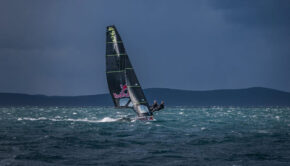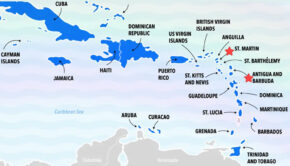IDEC Sport: Better But Not Best
Published on November 27th, 2015
(November 27, 2015; Day 6) – The six sailors on IDEC SPORT have been sailing in the Southern Hemisphere since 0300hrs this morning. They crossed the Equator after 5 days and 1 hour, almost 14 hours ahead of the time they had to beat.
However, the Spindrift 2 team, which is in dual pursuit of the Jules Verne Trophy, posted a better time. By switching hemisphere at 0131hrs GMT (0231hrs French time), skipper Yann Guichard and the crew on Spindrift 2 set a new record time of 4 days, 21 hours, 29 minutes, bettering the previous record held by Loïck Peyron and his crew on Banque Populaire V of 5 days 14 hours and 55 minutes. Spindrift 2 crossed the start line just under 2 hours after IDEC SPORT.
Improving on Peyron’s pace was predicted and they managed to do it. “We had a drink together and raised our glasses,” explained Francis Joyon, quite pleased with his express first stretch of the Jules Verne Trophy, which involved diving down the North Atlantic. “It’s fantastic. We’ve had a great race so far. The crew and the boat have both done very well. Due to a lack of time, we didn’t have much time to train in rough conditions and we discovered a lot. I’m really pleased.”
More stable conditions
So, that’s one thing out of the way. With a lead of almost 14 hours and with the gap widening over the record pace (266 miles at 1400hrs), everything is going well. Particularly as the conditions are much more stable (trade winds blowing between 13 and 20 knots this lunchtime) and more pleasant conditions than in the Doldrums. Gwénolé Gahinet, again: “The conditions are quite pleasant, brilliant sunshine, fairly calm seas and a SE’ly wind that isn’t that strong, but it’s nice out here.” To be honest, the crew wouldn’t mind a little more wind… “Or maybe we should ask our technical director to bring us the big mast(IDEC SPORT has two and deliberately set off with the smaller one, which is lighter – editor’s note) “ joked Francis Joyon. “But I had a look in the rule book and you’re not allowed to change the mast during the race (laughs). Having said that, we were quite happy with our small mast in the northern part, It was the rig we needed and we got through it well. We know too that it will be a great help in the Southern Ocean, so before that we have to adapt to the situation.”
In joking mood and sounding upbeat, as you would expect from someone, who has escaped from the clutches of the Doldrums… all lights are green. What they have to do now I find the best route to get to the Cape of Good Hope at the tip of South Africa. In order to achieve that goal, they are trying to time it right to hop onto a series of low-pressure areas moving away from South America. Today, they don’t have much else to think about other than speeding south as quickly as possible. However, Marcel (Van Triest, the router) has warned us that there is an area of uncertainty between 10 and 20 degrees South. “On the charts, it is looking good, but in reality out on the water, it risks being more complicated. We may get into calms with lots of manoeuvres to carry out to make our way south.”
Time for a breather before the transition
As for life on board, there are no worries either and the crew is doing well. “Of course, there was a little bit of tiredness as we made our way through the Doldrums, where the watch schedule fell to bits. I spent the night awake and the lads missed out on some of their rest periods too. But last night, we were able to recuperate. We charged up our batteries and we’re all in good shape and feeling good. We made a nice little video as we crossed the Equator (broadcast on Breakfast TV in France), where we raised out glasses to Neptune. I haven’t seen the finished version, but I raised my glass.”
They are the latest developments for the sailors aboard IDEC SPORT, sailing a long way off the coast of Brazil. Another hurdle lies ahead with the transition zone to get through. The next big moment will be crossing the line to the south of the Cape of Good Hope, marking their entry into the Indian Ocean and the huge open expanse of the Southern Ocean, which is part of the legend of round the world racing. We don’t need to panic, if IDEC SPORT is a bit behind the record pace at that point, because of the uncertainty in the South Atlantic. “We’re not forgetting our main goal,” Francis Joyon reassured us, “what counts is the time at the finish, not the intermediate ones.” So that is clear.
As of 1615 UTC
Distance to finish: 19220.8 nm
Distance for 24 hours: 540.63 nm
Distance ahead of record: 270.06 nm
Source: IDEC SPORT
The crew of IDEC SPORT:
Francis Joyon (FRA)
Bernard Stamm (SUI)
Gwénolé Gahinet (FRA)
Alex Pella (ESP)
Clément Surtel (FRA)
Boris Herrmann (GER)
Team website – Tracker – Facebook
Background: The Jules Verne Trophy is a prize for the fastest circumnavigation of the world by any type of yacht with no restrictions on the size of the crew, starting and finishing between the Le Créac’h Lighthouse off the tip of Brittany and the Lizard Point in Cornwall. Francis Joyon (FRA), skippering the 31.5m VPLP-designed trimaran IDEC SPORT, crossed the start line on November 22 at 02:02:22 GMT for his assault on the Jules Verne Trophy. The 6-man team must return by 15:44:15 UTC on January 6, 2016 to beat the current record set January 2012 by Loïck Peyron and his crew on Banque Populaire V of 45 days, 13 hours, 42 minutes and 53 seconds.
MORE: Also starting on November 22 (at 4:01:58 GMT) for an attempt at the Jules Verne Trophy was the 40m VPLP-designed Spindrift 2, led by Yann Guichard. The 14-person team must return before 17:43:51 GMT on January 6, 2016 to beat the record. Here’s a tracker showing both teams: http://volodiaja.net/Tracking/









 We’ll keep your information safe.
We’ll keep your information safe.